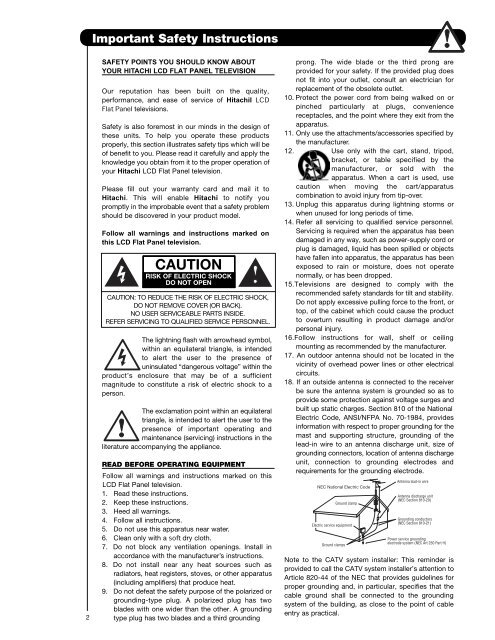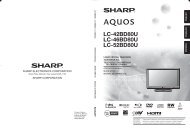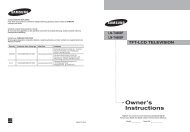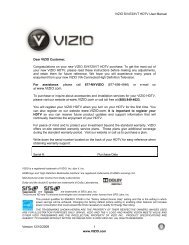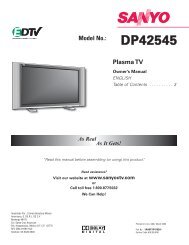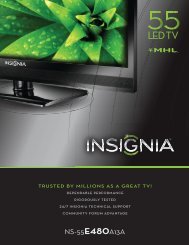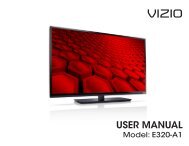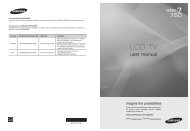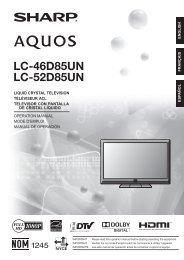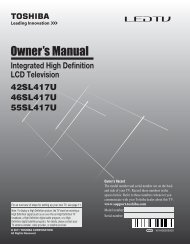LCD Flat Panel TELEVISION Operating Guide ... - Hitachi in Canada
LCD Flat Panel TELEVISION Operating Guide ... - Hitachi in Canada
LCD Flat Panel TELEVISION Operating Guide ... - Hitachi in Canada
Create successful ePaper yourself
Turn your PDF publications into a flip-book with our unique Google optimized e-Paper software.
Important Safety Instructions<br />
2<br />
SAFETY POINTS YOU SHOULD KNOW ABOUT<br />
YOUR HITACHI <strong>LCD</strong> FLAT PANEL <strong>TELEVISION</strong><br />
Our reputation has been built on the quality,<br />
performance, and ease of service of <strong>Hitachi</strong>I<br />
<strong>Flat</strong> <strong>Panel</strong><br />
<strong>LCD</strong><br />
televisions.<br />
Safety is also foremost <strong>in</strong> our m<strong>in</strong>ds <strong>in</strong> the design of<br />
these units. To help you operate these products<br />
properly, this section illustrates safety tips which will be<br />
of benefit to you. Please read it carefully and apply the<br />
knowledge you obta<strong>in</strong> from it to the proper operation of<br />
your <strong>Hitachi</strong> <strong>LCD</strong> <strong>Flat</strong> <strong>Panel</strong> television.<br />
Please fill out your warranty card and mail it to<br />
<strong>Hitachi</strong>. This will enable <strong>Hitachi</strong> to notify you<br />
promptly <strong>in</strong> the improbable event that a safety problem<br />
should be discovered <strong>in</strong> your product model.<br />
Follow all warn<strong>in</strong>gs and <strong>in</strong>structions marked on<br />
this <strong>LCD</strong> <strong>Flat</strong> <strong>Panel</strong> television.<br />
CAUTION<br />
RISK OF ELECTRIC SHOCK<br />
DO NOT OPEN<br />
CAUTION: TO REDUCE THE RISK OF ELECTRIC SHOCK,<br />
DO NOT REMOVE COVER (OR BACK).<br />
NO USER SERVICEABLE PARTS INSIDE.<br />
REFER SERVICING TO QUALIFIED SERVICE PERSONNEL.<br />
The lightn<strong>in</strong>g flash with arrowhead symbol,<br />
with<strong>in</strong> an equilateral triangle, is <strong>in</strong>tended<br />
to alert the user to the presence of<br />
un<strong>in</strong>sulated “dangerous voltage” with<strong>in</strong> the<br />
product’s enclosure that may be of a sufficient<br />
magnitude to constitute a risk of electric shock to a<br />
person.<br />
The exclamation po<strong>in</strong>t with<strong>in</strong> an equilateral<br />
triangle, is <strong>in</strong>tended to alert the user to the<br />
presence of important operat<strong>in</strong>g and<br />
ma<strong>in</strong>tenance (servic<strong>in</strong>g) <strong>in</strong>structions <strong>in</strong> the<br />
literature accompany<strong>in</strong>g the appliance.<br />
READ BEFORE OPERATING EQUIPMENT<br />
Follow all warn<strong>in</strong>gs and <strong>in</strong>structions marked on this<br />
<strong>LCD</strong> <strong>Flat</strong> <strong>Panel</strong> television.<br />
1. Read these <strong>in</strong>structions.<br />
2. Keep these <strong>in</strong>structions.<br />
3. Heed all warn<strong>in</strong>gs.<br />
4. Follow all <strong>in</strong>structions.<br />
5. Do not use this apparatus near water.<br />
6. Clean only with a soft dry cloth.<br />
7. Do not block any ventilation open<strong>in</strong>gs. Install <strong>in</strong><br />
accordance with the manufacturer’s <strong>in</strong>structions.<br />
8. Do not <strong>in</strong>stall near any heat sources such as<br />
radiators, heat registers, stoves, or other apparatus<br />
(<strong>in</strong>clud<strong>in</strong>g amplifiers) that produce heat.<br />
9. Do not defeat the safety purpose of the polarized or<br />
ground<strong>in</strong>g-type plug. A polarized plug has two<br />
blades with one wider than the other. A ground<strong>in</strong>g<br />
type plug has two blades and a third ground<strong>in</strong>g<br />
prong. The wide blade or the third prong are<br />
provided for your safety. If the provided plug does<br />
not fit <strong>in</strong>to your outlet, consult an electrician for<br />
replacement of the obsolete outlet.<br />
10. Protect the power cord from be<strong>in</strong>g walked on or<br />
p<strong>in</strong>ched particularly at plugs, convenience<br />
receptacles, and the po<strong>in</strong>t where they exit from the<br />
apparatus.<br />
11. Only use the attachments/accessories specified by<br />
the manufacturer.<br />
12. Use only with the cart, stand, tripod,<br />
bracket, or table specified by the<br />
manufacturer, or sold with the<br />
apparatus. When a cart is used, use<br />
caution when mov<strong>in</strong>g the cart/apparatus<br />
comb<strong>in</strong>ation to avoid <strong>in</strong>jury from tip-over.<br />
13. Unplug this apparatus dur<strong>in</strong>g lightn<strong>in</strong>g storms or<br />
when unused for long periods of time.<br />
14. Refer all servic<strong>in</strong>g to qualified service personnel.<br />
Servic<strong>in</strong>g is required when the apparatus has been<br />
damaged <strong>in</strong> any way, such as power-supply cord or<br />
plug is damaged, liquid has been spilled or objects<br />
have fallen <strong>in</strong>to apparatus, the apparatus has been<br />
exposed to ra<strong>in</strong> or moisture, does not operate<br />
normally, or has been dropped.<br />
15.Televisions are designed to comply with the<br />
recommended safety standards for tilt and stability.<br />
Do not apply excessive pull<strong>in</strong>g force to the front, or<br />
top, of the cab<strong>in</strong>et which could cause the product<br />
to overturn result<strong>in</strong>g <strong>in</strong> product damage and/or<br />
personal <strong>in</strong>jury.<br />
16.Follow <strong>in</strong>structions for wall, shelf or ceil<strong>in</strong>g<br />
mount<strong>in</strong>g as recommended by the manufacturer.<br />
17. An outdoor antenna should not be located <strong>in</strong> the<br />
vic<strong>in</strong>ity of overhead power l<strong>in</strong>es or other electrical<br />
circuits.<br />
18. If an outside antenna is connected to the receiver<br />
be sure the antenna system is grounded so as to<br />
provide some protection aga<strong>in</strong>st voltage surges and<br />
built up static charges. Section 810 of the National<br />
Electric Code, ANSI/NFPA No. 70-1984, provides<br />
<strong>in</strong>formation with respect to proper ground<strong>in</strong>g for the<br />
mast and support<strong>in</strong>g structure, ground<strong>in</strong>g of the<br />
lead-<strong>in</strong> wire to an antenna discharge unit, size of<br />
ground<strong>in</strong>g connectors, location of antenna discharge<br />
unit, connection to ground<strong>in</strong>g electrodes and<br />
requirements for the ground<strong>in</strong>g electrode.<br />
NEC National Electric Code<br />
Note to the CATV system <strong>in</strong>staller: This rem<strong>in</strong>der is<br />
provided to call the CATV system <strong>in</strong>staller’s attention to<br />
Article 820-44 of the NEC that provides guidel<strong>in</strong>es for<br />
proper ground<strong>in</strong>g and, <strong>in</strong> particular, specifies that the<br />
cable ground shall be connected to the ground<strong>in</strong>g<br />
system of the build<strong>in</strong>g, as close to the po<strong>in</strong>t of cable<br />
entry as practical.


